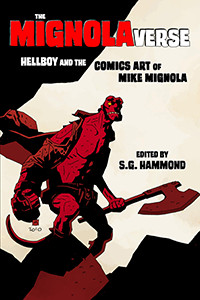Negative Space does everything a good comic should do. It tells a great story, with clarity, uses the visual elements well (this story wouldn’t be as powerful without the art) and has some of the best high-octane snarky dialogue this side of Archer. But despite its elaborate sci-fi and action elements, at its core, it’s a form of talk therapy for depression, or at least a long meditation on the nature of sadness and happiness. It’s a book about emotions, and the power they have to shape the world. That’s a rare and wonderful combination, and continues, in its third issue, to be a strong and unique addition to the comics landscape.
Writer Ryan K. Lindsay has a real ear for dialogue, and the snappy repartee between the characters, even though some of them are tentacled aliens, helps to keep the tone light. This is not an insignificant point, because this sort of material could easily become deadly serious. The book, and issue #3 deepens this theme, discusses and dissects depression and suicide, reaching back to family tragedy and positing elaborate conspiracies to keep the world feeling hopeless today. In the hands of a lesser writer, that could all read as analytical and serious, like listening in on someone’s private counselling session. But Lindsay, without losing any of the content or sidestepping any of the truly tragic issues, builds talk therapy into chase scenes, where it almost becomes action movie exposition. Done well, as it is here, we may not even notice how serious the discussion is, particularly between the characters of Guy and Beta, until the second or third reading. The plot moves forward with real momentum here — as we mentioned, this issue features a long chase scene involving arming and detonating a bomb — but one could linger over panels and pages to appreciate the power of the story being told, and the art. That’s great comics storytelling.
The art, by Owen Gieni, is uniformly excellent, featuring his sensitive, textured style. His use of strong colours, such as pink and magenta and turquoise, give the panels depth and power, and allow the yellow-orange-clad heroes to stand out from the page. Gieni also gives us a great splash page in issue #3 with a “black and white” flashback sequence overlain with a spectrum of his distinctive palette. This again is a good choice for this sort of comic, as a lesser artist would have just gone “dark” all the way through. These are creators who understand that telling a great story in comics means using colour, shape, texture and dialogue in creative and unexpected ways.
The story itself, about which I’ll try not to spoil anything, picks up right where we left off in issue #2. Guy, a suicidal human writer, and Beta, an alien flower monster with a knack for witty asides, are on a mission to arm and detonate a happiness bomb deep under the ocean. The idea is that this bomb will eradicate the Evorah (Beta’s people), emotionally sensitive aliens who came to earth 1000 years ago in order to feed off humanity’s sadness. In the previous issue, we found out that the Evorah have been working with a group of humans, who deliberately plant bad news and generally try to make the world a grimmer place, in exchange for not rising out of the ocean (remember: flower monsters) and destroying the world. Beta is a rogue Evorah who doesn’t have a taste for depression, and is working with a group of resistance fighting humans, determined to inject happiness into the world. Guy is tasked with filling the bomb with good feelings and bringing it down to the heart of the Evorah. He might seem an unlikely choice, since he himself is the poster child for depression and loneliness, but he has an especially acute emotional sensitivity, and this makes him quite suitable for the job. And, in this issue, to his great surprise, he discovers that he’s better at this than he thought.
The key to “saving the day” in this comic is for a very depressed man to somehow project an overflowing fountain of happiness into the world. That’s a challenge, and kudos to Lindsay for finding a way to make that happen that honours Guy’s depression and doesn’t seem fake. Depression is quite real, and Guy has very good reasons for being the way he is. In the “extended therapy session” that is this issue, he makes a real breakthrough, and one that is earned by the dramatic heft of the narrative. More than anything else, the comic shows us that happiness can come from unexpected places, and there’s a freedom that arrives along with acceptance of certain feelings and past events. So, besides everything else, Negative Space is its own form of therapy. And one heck of an entertaining read.



















































